THURSDAY'S SCRIPT TIP:
BLOCKBUSTER CHARACTERS

For some reason, whenever there's some message board proclamation that Hollywood sucks, the person who posts always objects to the idea of having to give up writing their deep, textured character dramas to write some silly Hollywood tentpole movie with hollow characters and big explosions. That writing commercial means writing bad. That you can either have good characters in an indie drama or cardboard characters in a mainstream film. That going commercial means no character arc and no character depth.
I say: Look Closer.
BLOCKBUSTER CHARACTER ARC
Though this is an old tip that probably needs updating, I saw AVENGERS: ENDGAME for the 3rd time recently, and my eyes were misty a few times...
In THOR: THE DARK WORLD (and the previous THOR movie) we get a family drama amongst the Gods... a touch of Steinbeck's EAST OF EDEN. Thor is the favored son of Odin, and Loki is the mischievous son who always gets into trouble... but his mother Frigga keeps bailing him out. This is one dysfunctional family... and the most powerful in the nine worlds. In DARK WORLD the brothers (who are bitter enemies) must work together to fight an outside threat. And that threat will tear his family apart, threaten the woman he loves (on Earth), and cause deaths that will rip Thor apart emotionally. The THOR series is *not* Marvel's flagship (that's IRON MAN), and is basically about a big lunkhead with a magic hammer... but they understand that *people* buy cinema tickets and ground the film in stories that are *about people*. It had elements of a family drama, with stern fathers and forgiving mothers and sibling rivalry and a family business in constant turmoil. Emotional stories. The genius of Stan Lee or whoever created this character decades ago was to make the story about family dynamics, and a boy torn between dealing with his messed up family at home while venturing into the world outside where he has met a girl... It's what every teenage boy in the world is dealing with! And every adult remembers from their childhood. A story based on real human emotions and conflicts that we can relate to... even though it's kind of the "throw away" Marvel Superhero series.

That WOLVERINE movie (2013) was a real surprise for me (since I hated the previous one), an adult story about mortality and regret. The Wolverine character is a mutant whose body heals no matter how badly he is wounded, making him immortal. The problem with being immortal is that you get to see the people you love die... again and again. Your entire life is sorrow and loss, and this film focuses on that. It opens with Wolverine saving the life of a young Japanese soldier during the atomic bombing of Nagasaki. Decades later, Wolverine is living alone in the woods... a haunted man... struggling with nightmares of killing the one woman he loved (Jean Grey), when he is approached by a Japanese woman who takes him to that young Japanese soldier who is now a dying old man. A dying old *wealthy* man, who offers Wolverine a chance to die and end his pain and sorrow. In exchange, the old man asks a favor... and that's when things begin to go wrong. A dying man and a man who can not die. A favor for Wolverine's oldest friend who will grant him an end to his pain... that's the plot of a superhero movie? Yes.
LOGAN (2017) took the Wolverine character even deeper into the drama genre - a character study of a drunk, burned out superhero who has no hope for the future who *can not die* (meaning he'll experience lots of that future). It's Oscar bait! Hugh Jackman gives an amazing performance, as does Patrick Stewart as Professor X suffereing from dementia. This film is *better* than most "serious dramas" and bring tissues - grown men were crying in the cinema where I watched it.
In SPIDER-MAN (the first one - not the reboot or the new reboot of the reboot) Peter Parker is riddled with guilt over causing the death of his Uncle Ben (father figure) and must battle the father of his *best friend* - a messy emotional dilemma. Throughout the film, every action scene is a messy dilemma - save a school bus full of cute kids or the woman you love? How can he even kill the father of his best friend... depriving him of a father the same way Peter's arrogance resulted in the murder of his Uncle Ben? At the beginning of the film, Peter was madly in love with the girl next door and would do anything to go out with her... by the end he has realized she will never be safe as long as she's with Peter - so he breaks up with her.

PIRATES OF THE CARIBBEAN is wall-to-wall character arc. Look at Will (or any other character - even the villain Barbosa) at the beginning of the story and compare that to who they are at the end of the story - completely different people! Now track back and find all of those difficult decisions they made in order to change from what they were to what they are. Will goes from good man to pirate... and this character is complex enough that he is *both* an good man and a pirate simultaneously. Even the villain is a fully developed three dimensional character - I get misty eyed when Barbosa talks about losing his ability to taste an apple in one scene... and if you just follow the Barbosa-apple thing, it's amazingly well done. The villain's emotional journey in the story is fleshed out, and his back story is fleshed out, and he has goals and desires and regrets and all of the other things you probably don't expect to find in a big blockbuster movie. All of the characters have depth in this film... and it's fast paced and exciting and things explode. It's the ultimate summer tentpole movie - spawned two sequels and maybe three - and yet it has complex characters who make one difficult decision after another which will test their character and expose their character and explore their character.

RAIDERS OF THE LOST ARK, often pointed out as a film with little in the way of character or character arc, begins with Indiana Jones as the most curious guy in the world - he spends the whole film chasing after that Lost Ark to find out what is inside it... and to possess it. Early on, Belloq tells Indy that they are exactly the same - both value objects over people. Indy doesn't believe this, but his single-mindedness causes the death of the woman he loves, Marion... and slowly he realizes that Belloq was right... so he begins to change his priorities... and by the end, when the contents of the Lost Ark are revealed - he has spent the whole film chasing it - he tells the woman he loves to close her eyes... and *Indy* closes his eyes, too. He no longer cares what is inside, he cares about Marion. Indiana Jones goes through a series of subtle changes throughout the story which may be difficult to see because of all of those great action set pieces, but are easier to see if you compare the character's goals and desires and actions at the beginning of the film with their goals and desires and action at the end of the film. Once you see the differences, you can trace them back through the script scene-by-scene and see all of those scenes where the character was faced with difficult decisions and chose the thing that was unlike what their character would have chosen at the beginning of the film.

The exception to characters who change may be James Bond, who is a series character, and like any series - TV or books like Sherlock Holmes - there is usually no change in the protagonist so that the series can be viewed or read out of order without confusion. And James Bond is a superhero of sorts - not an everyman but a superman. We enjoy Bond movies because he unzips his wetsuit and he's wearing a formal dinner jacket underneath. This guy is our fantasy... not a real persona at all. But ask a real Bond fan what their favorite movie is, and they will say ON HER MAJESTY'S SECRET SERVICE - the one that is all about Bond's emotional issues, where Bond *gets* emotional and cries. When Bond lets down his armor and shows his vulnerability. And that is one of the reasons why CASINO ROYALE was a hit - Bond lowered his armor for Vesper, and got hurt. Because this was a reboot movie, we are seeing the reasons why Bond wears that armor over his emotions in the first place in this film - we learn why he doesn't get emotionally involved later in his career. But every Bond film, even the Roger Moore fiascos, always have at least one scene where Bond gets emotional... just to show he is human and allow the audience a peek at the man behind the armor (which helps us identify with him). Here's the thing - ask any of those writers who complain about having to write shallow characters if they would be interested in writing a James Bond movie and most would jump at the chance!
CHARACTER DRIVEN BLOCKBUSTERS

The first three Jason Bourne movies are what Hollywood calls character driven! In BOURNE SUPREMACY the woman Bourne loves is killed by an assassin, and Bourne spends the whole movie chasing the guy to extract revenge...
But the story really begins with Bourne's nightmares - he keeps remembering bits and pieces of his past, bits and pieces of assassinations, bits and pieces of his life as a villain. What is great about the Bourne character is that he is a villain *and* a hero in one - a man having to come to grips with his past. And each film has him exploring that past - digging into his *character* and having to face the things he most dislikes about himself. And his past sins are what trigger the murder of the woman he loves.
The Russian assassin is trying to kill Bourne, who murdered a Russian dignitary and his wife many years ago as part of a scheme... and now the conspiracy behind the scheme is falling apart and they need Bourne out of the way.
Bourne and the Russian Assassin are reflections of each other - similar characters - which forces Bourne to deal with his past... and deal with his guilt. He murdered people. How is he any better than this assassin who murdered the woman he loves? By the time he catches up with the assassin, he has an easy shot at killing him and getting revenge... but he *does not*. And right after that he tracks down the daughter of those two assassination victims - her mother and father - and apologizes to her. He takes responsibility for his past... and proves that he is *not* a man of violence any more. Name a serious drama that delves that deep into issues of guilt and regret and making atonement? The great thing about a big action flick or some other mainstream genre film is that the raised stakes create *more drama* and allows us to dig deeper into characters. A life or death situation can force a character to think of their own mortality, and their regrets about their lives.
CHARACTER DEMONSTRATED

It might be easy to miss the characterization because of all of those car chases and explosions - all of that *action* - but we are talking about *movies* here. The job of the screenwriter is to tell the story (whether it's action or comedy or rom-com or whatever) through the *actions* of the characters. They *demonstrate* the change through what they *do* in the story. We write pictures. Look at what the characters *do* - that is what shows us who they are... and how they change. A small indie drama might have pages of speechifying where a character *talks* about all of his life's emotional issues, making it *obvious*. But we usually don't want to be obvious, we want to be clever and dig below that surface. If you are only looking at what a character *says* you may completely miss what they *do* - which shows us who they really are. One of the reasons why many people miss the characterization in some big Hollywood movie like SPIDER-MAN or the Bourne movies or BATMAN BEGINS is that they ignore the actions of the characters. They see Bourne *not* kill the Russian assassin after the car chase and think it is just part of the action plot, not a character scene. In a good film, the action scenes *are* character scenes, and a screenwriter's job is to infuse the action scenes with character, and to make the action scenes all about making difficult decisions that expose character. If you think writing a scene where a character *tells us* about his emotional issues is difficult, try writing a scene that demonstrates their emotional struggle in an epic battle with Green Goblin!
The great thing about Blockbusters and good mainstream movies is that they connect with the audience on an emotional level, which is why they make all of that money. Sure, some people may go on opening weekend to see the big explosions and the CGI work, but if the film is going to keep selling tickets it needs a human story. People care about Peter Parker and Jason Bourne... and worry about them. That's what makes the action and suspense work - we care about these characters. The studios, who invest in screenplays, want to find screenplays that connect to the largest possible audience. Why buy a script with limited appeal? That's a bad investment.
I think if you take 10 random indie films and 10 random studio films, you will find more of the studio films with real character arcs and real character scenes... though those studio character scenes may not be dialogue scenes. Because the studios know that humans buy cinema tickets and showing the human side of a super hero or spy or pirate connects with the audience, so they make sure - for purely financial reasons - that there are character scenes and situations in the movie. In the indie world, movies are often made for the filmmaker and not for money, and often scenes that really dig deep into character are just not there. The stories are soft and often emotionally evasive. Characters are never tested or forced to deal with their issues or have anything other than conversations about emotions - with no actual emotional scenes.
When you have to make the decision between a school bus full of kids and the woman you love, you have to dig deep into your character and emotions... if you're a slacker musician who has a crush on some girl but can't bring yourself to say so for 84 minutes of screentime, that's just surface character.

An indie drama like MUTUAL APPRECIATION is all surface without ever digging into the character and motivation of the lead character. I'm not cherry-picking some dreadful indie drama as a bad example, Andrew Bujalski's MUTUAL APPRECIATION was the opening film at an international film festival I attended and is a key film in the mumblecore movement, won some awards and got a bunch of great reviews for its slice-of-life realism. It's the story of a guitar player who has a mild crush on a friend's wife... and does nothing about it. But the crush part doesn't really become part of the plot until Act 3, before that it's just the guitar player in New York City. No real conflict, no drama, obviously no explosions. It's the kind of slow paced film where nothing much happens that is usually referred to as a "character study"; except I hope they don't have a test because after 110 minutes of study I know nothing about the character. I only know the surface - he's a guitar player in New York City.
The film was all wish-fulfilment for the filmmaker. The guitar player is *instantly* discovered and *instantly* gets an amazing concert gig and *instantly* has a hot radio DJ throw herself at him and *instantly* lands a record deal with a major label that calls him a genius... even though we've heard his music and it's not all that great. The character never has to work for anything! Never has to deal with any of his own failings! He just doesn't have any failings, no regrets, no emotional problems... except that crush on his best friend's wife thing that is never explored in the film. Why? Let's dig below the surface and get into motivations! But the guitar guy does nothing - he does not steal his friend's wife, so he doesn't have to deal with the emotional issues that may come from that. He is just this perfect surface person with unbelievable luck.
We never get to study the character because the character is never in any position where they must make a difficult decision or regret the decisions they have made. Because there are no explosions and was slow paced, all of those critics who loved it thought it must be about the character. But what do we ever learn about the character? Nada. His character is never tested.
Hey, you can't really have a character study without the character being tested!
In SPIDER-MAN Peter Parker has to struggle with his guilt over causing the death of his father-figure... he has to deal with his emotional conflict and his regrets and his own failings. There's a *reason* why those Blockbusters connect to so many people - the emotions go deeper. Characters are forced by circumstances to deal with those big ugly emotional issues, forced to deal with their failings, forced to make those awful decisions we hope we will never have to make in real life. The bigger the stakes, the deeper the drama.
THAT'S CRAPTASTIC!

Yes, there are bad blockbusters that seem to coast on amazing spectacle and big explosions. Usually they flop, but every once in a while people buy tickets for some big dumb movie like TRANSFORMERS 3... there's probably one or two of those a year - a movie that people see more as an event than a story. And there are plenty of blockbuster flops. But there is no requirement that a popular film has to be stupid. If anything, box office would prove otherwise. Those crappy soul-less blockbusters tend not to spawn sequels. The gross-out comedies without heart tend to die an early death. There is usually a reason why one blockbuster fails and another succeeds.
The problem with bad blockbusters is not that they are blockbusters, it's that they're bad. They were either poorly written or developed into crap and ended up all surface material like explosions and CGI and no character or character depth.
The big mistake is thinking that popular entertainment is some sort of lesser art form with lower standards and requiring lesser efforts. If popular entertainment were simple and easy to write, every mainstream film would be a hit and every mainstream film would *work*... but as we all know, many do not. Writing any screenplay is difficult, and writing a screenplay designed to work for hundreds of millions of people worldwide is danged close to impossible. I think the first step in creating better blockbuster movies is to acknowledge just how difficult it is to write one that only works on an *entertainment level*. Writing a mainstream popular film requires a skill set that you aren't born with... you have to work your butt off to learn and master. Hey, a blockbuster with great characters that doesn't work at all as entertainment is pointless. As I often say, screenwriting isn't an "either / or" situation, it's *both*. You need to be able to master those skills to create popular entertainment *and* create great characters and stories that resonate with the audience.
WE CAN ADD CHARACTER LATER

And the idea of just pasting on character and quality from the outside doesn't work - those great characters have to be part of the core of the story. Look at the BOURNE movies - the story comes from the character... as do the action scenes. That "school bus or the woman you love" action scene in SPIDER-MAN is all about the character. Not an action scenes pasted on just to make the story exciting, nor the character and characterization pasted on to some random action scene - the scene itself is both exciting *and* character oriented. That is why writing good popular entertainment isn't easy - you need to do everything at once. You must have mastered the character and quality and excitement and blockbuster skills.
We are in a cycle of superhero movies right now, but that doesn't mean those films have to be stupid or ignore character. Whether your story is about a family of Gods on Asgard or the Royal family of Denmark or a farm family dealing with foreclosure, all are just mediums for drama and character and story. It's not that it's a "dumb superhero movie" it's that something is a *dumb movie*. You can just as easily have a great superhero movie and a dumb "serious indie movie". Our job is to write the great version of any story.
Popular entertainment isn't a lesser form that requires lesser effort, it's a more complicated form that requires greater effort... and greater skills. Make your characters part of the story, and the excitement part of the story. Chart out your character arcs and emotional moments so that they are part of story and not something added as an afterthought. If the character scenes are *also* the big, exciting scenes they can not be removed from the script in development (or, are more difficult to remove - those development folks are skilled at their jobs). We don't need any more bad popular films weak characters, nor is the answer trying to force people to see some art house film. The solution is to master all of the skills and create great popular film with great characters. THE DARK KNIGHT proves that if you create a quality blockbuster film with complex characters forced to make difficult decisions, people will want to see it again and again.
Our job is to write those high quality, character oriented, blockbuster screenplays. We need to look closer, to see with better eyes.
BRAND NEW!
How Do I do That?

101 SCREENWRITING ANSWERS Blue Book!
New to screenwriting? You probably have questions! How do I get an Agent? How do I write a phone conversation? Do I need a Mentor? What’s does VO and OC and OS mean? What is proper screenplay format? Should I use a pen name? Do I need to movie to Hollywood? What’s the difference between a Producer and a Production Manager, and which should I sell my script to? How do I write a Text Message? Should I Copyright or WGA register my script? Can I Direct or Star? How do I write an Improvised scene? Overcoming Writer’s Block? How do I write a Sex Scene? And many many more! This book has the answers to the 101 Most Asked Questions from new screenwriters! Everything you need to know to begin writing your screenplay!
All of the answers you need to know, from a working professional screenwriter with 20 produced films and a new movie made for a major streaming service in 2023!
Only $4.99
NEW!!!
Can You Make It bigger?

BLOCKBUSTERS (and BEACH READS) Blue Book!
Writing something EPIC?
ONLY: $4.99!
Thinking about writing a big Disaster Movie? An Historical Epic? An Epic Adventure Film? Or maybe you like Gladiator Movies? This book looks at writing Blockbusters and those Big Fat Beach Read novels - anything epic! Usng movies like JAWS, POSEIDON ADVENTURE, LAWRENCE OF ARABIA, THE GUNS OF NAVARONE, and those MARVEL and FAST & FURIOUS flicks as examples. What *is* a Blockbuster? 107 years of Blockbuster history! Blockbuster Characters. Blockbuster Story Types! Why modern Blockbusters are soap operas! Social Issues in Blcokbusters? Big Emotions! Keeping All Of Those Characters Distinctive! How to avoid the Big problems found in Big Movies and books! More! If you are writing a Big Event Movie or a Big Fat Novel, there are tips and techniques to help you!
Only $4.99
BRAND NEW!
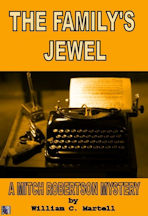
***
MITCH ROBERTSON #2: THE FAMILY'S JEWEL *** - For Kindle!
"The Presidential Suite of the Hollywood Hoover Hotel looked like a bloody battlefield: bodies everywhere, furniture broken, red liquid dripping from the walls, dead soldiers littering the elegant Berber rug as clouds of smoke overhead bounced between two air conditioning vents.
Mitch Robertson stepped over the body of an ex-child star turned sex tape star turned pop star and entered the room, spotted a gun on the floor and picked it up... careful not to spill his coffee with three pumps of mocha syrup from Penny’s Coffee Shop. That coffee was gold, the only thing keeping him going in this dazed state of wakefulness. The gun felt light. Holding it, he saw the silhouette of an 80s action star sitting sideways on a tipped over chair. Motionless. Was he dead? Mitch was still hung over from the Awards Party the night before, and wondered whether this was all some sort of crazy nightmare that he would wake up from... but when he tripped over the brown legs of a bottomless Superhero, flaccid junk encased in a condom but still wearing his mask, and hit the edge of the sofa, gun skittering and coffee spilling, he realized that it was all very real. What the hell had happened here?"
Short Novel. Only 99 cents - and no postage!
IT'S NEW!!
All About Rewrites!
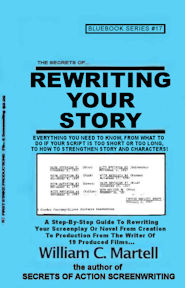
REWRITES Blue Book!
Rewriting In Waves?
When You Finish Your Screenplay Or Novel...
The Rewrites Begin!
The end is just the beginning! You’ve finished your story, but now the rewriting begins! This 405 page book shows you how to rewrite your screenplay or novel to perfection. Everything from Character Consistency to Shoeboxing to How To Give And Receive Notes to 15 Solutions If Your Script’s Too Long! and 15 Solutions If Your Script’s Too Short! to Finding The Cause Of A Story Problem to Good Notes Vs. Bad Notes to Finding Beta Readers to Avoiding Predictability to Learning To Be Objective About Your Work to Script Killer Notes and Notes From Idiots to Production Rewrites and What The Page Colors Mean? and a Complete Rewrite Checklist! The complete book on Rewriting Your Story!
Only: $4.99
HITCHCOCK FOR WRITERS!
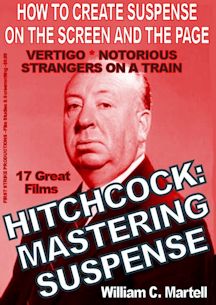
LEARN SUSPENSE FROM THE MASTER!
*** HITCHCOCK: MASTERING SUSPENSE *** - For Kindle!
Alfred Hitchcock, who directed 52 movies, was known as the *Master Of Suspense*; but what exactly is suspense and how can *we* master it? How does suspense work? How can *we* create “Hitchcockian” suspense scenes in our screenplays, novels, stories and films?
This book uses seventeen of Hitchcock’s films to show the difference between suspense and surprise, how to use “focus objects” to create suspense, the 20 iconic suspense scenes and situations, how plot twists work, using secrets for suspense, how to use Dread (the cousin of suspense) in horror stories, and dozens of other amazing storytelling lessons. From classics like “Strangers On A Train” and “The Birds” and “Vertigo” and “To Catch A Thief” to older films from the British period like “The 39 Steps” and “The Man Who Knew Too Much” to his hits from the silent era like “The Lodger” (about Jack The Ripper), we’ll look at all of the techniques to create suspense!
Only $5.99
NO KINDLE REQUIRED! Get the *free* app (any device, except your Mr. Coffee) on the order page on Amazon!
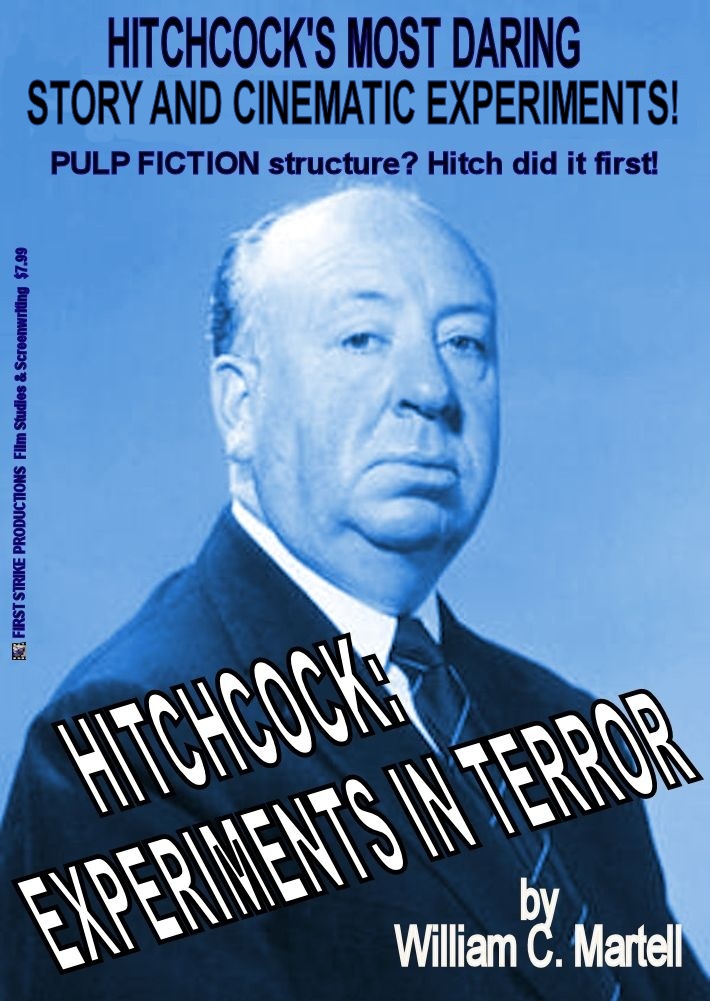
Strange Structures!
*** HITCHCOCK: EXPERIMENTS IN TERROR! *** - For Kindle!
***
Contained Thrillers like "Buried"? Serial Protagonists like "Place Beyond The Pines"? Multiple Connecting Stories like "Pulp Fiction"? Same Story Multiple Times like "Run, Lola, Run"?
HITCHCOCK DID IT FIRST!
This book focuses on 18 of Hitchcock's 52 films with wild cinema and story experiments which paved the way for modern films. Almost one hundred different experiments that you may think are recent cinema or story inventions... but some date back to Hitchcock's *silent* films! We'll examine these experiments and how they work. Great for film makers, screenwriters, film fans, producers and directors.
Only $5.99 - and no postage!
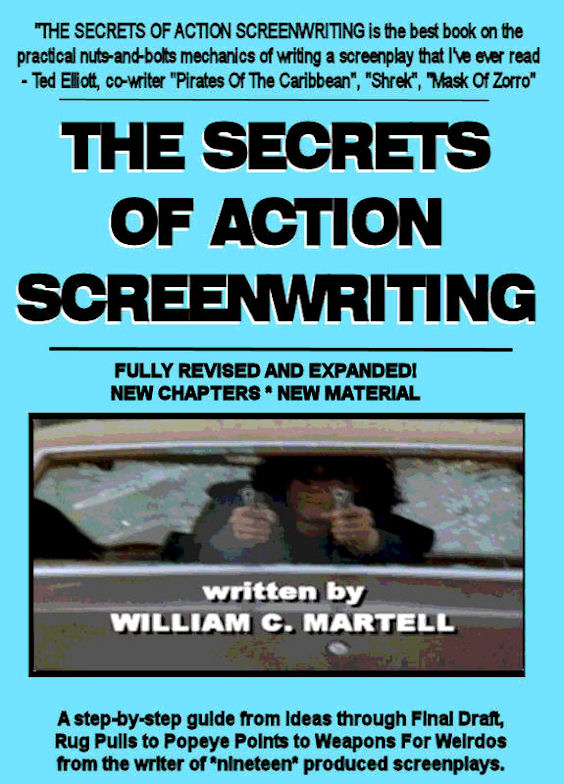
MAKES A GREAT GIFT!
*** THE SECRETS OF ACTION SCREENWRITING *** - For Kindle!
*** THE SECRETS OF ACTION SCREENWRITING *** - For Nook!
Why pay $510 for a used version of the 240 page 2000 version that used to retail for $21.95? (check it out!) when
you can get the NEW EXPANDED VERSION - over 500 pages - for just $9.99? New chapters, New examples, New techniques!
"SECRETS OF ACTION SCREENWRITING is the
best book on the practical nuts-and-bolts mechanics of writing a screenplay I've ever read."
- Ted Elliott, co-writer of MASK OF ZORRO, SHREK, PIRATES OF THE CARIBBEAN and the sequels (with Terry Rossio). (ie; 4 of the top 20 Box Office Hits Of ALL TIME.)
Only $9.99 - and no postage!
Tip FAQ

My New Script Secrets Newsletter!

STORY IN ACTION SERIES!

THE MISSION IMPOSSIBLE MOVIES
NEW: Updates On Films 7 & 8 Casting!
All Six Movies analyzed! All of the mission tapes, all of the “that’s impossible!” set pieces and stunts, the cons and capers - and how these scenes work, the twists and double crosses, the tension and suspense (and how to generate it), the concept of each film as a stand alone with a different director calling the shots (broken in the sixth film), the gadgets, the masks, the stories, the co-stars and team members (one team member has been in every film), the stunts Tom Cruise actually did (and the ones he didn’t), and so much more! Over 120,000 words of fun info!
THE MISSION IMPOSSIBLE MOVIES - 347 Pages - Only $3.99 !

BRAND NEW!
*** THE BOURNE MOVIES
NEW: Updates on TREADSTONE TV show!
All five "Bourne" movies (including "Legacy" and it's potential sequels) - what are the techniques used to keep the characters and scenes exciting and involving? Reinventing the thriller genre...
or following the "formula"? Five films - each with an interesting experiment! A detailed analysis of each
of the films, the way these thrillers work... as well as a complete list of box office and critical
statistics for each film. This book is great for writers, directors, and just fans of the series.
Only $3.99 - and no postage!
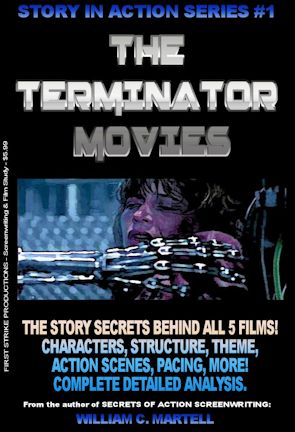
Over 240 pages!
*** THE TERMINATOR MOVIES *** - For Kindle!
He's back! The release of "Terminator: Dark Fate" is set to begin a new trilogy in
the Terminator story... 35 years after the first film was released. What draws us to these films about
a cybernetic organism from the future sent back in time? Why is there a new proposed trilogy every few
years? This book looks at all five Terminator movies from a story standpoint - what makes them work
(or not)? What are the techniques used to keep the characters and scenes exciting and involving? How
about those secret story details you may not have noticed? Containing a detailed analysis of each of
the five films so far, this book delves into the way these stories work... as well as a complete list of
box office and critical statistics for each film. This book is great for writers, directors, and just
fans of the series.
ONLY $3.99 - and no postage!
NO KINDLE REQUIRED! Get the *free* app (any device, except your Mr. Coffee) on the order page on Amazon!

NEW BUT OLD!
*** VINTAGE #1: HOW TO WRITE PHOTOPLAYS *** - For Kindle!
***
Screenwriting books have been around as long as films have. This series reprints vintage screenwriting books with a new introduction and history, plus new articles which look at how these lessons from almost 100 years ago apply to today’s screenplays. Anita Loos book is filled with information which still applies.
In addition to the full text of the original book, you get the full screenplay to Miss Loos' hit THE LOVE EXPERT, plus several new articles on the time period and women in Hollywood.
Only $2.99 - and no postage!
THE BLUE BOOKS!
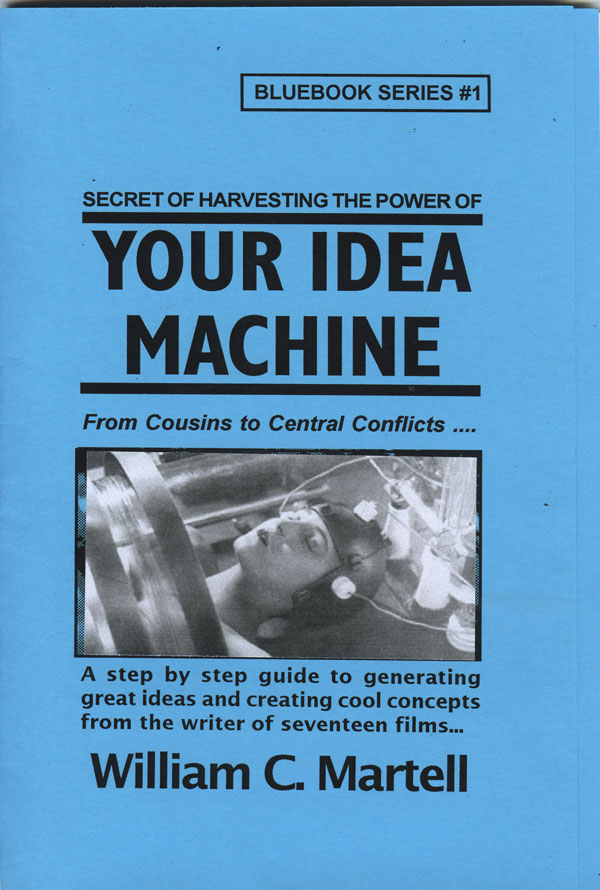
FIND A GREAT IDEA!
*** YOUR IDEA MACHINE *** - For Kindle!
****
Expanded version with more ways to find great ideas! Your screenplay is going to begin with an idea. There are good ideas and bad ideas and commercial ideas and personal ideas. But where do you find ideas in the first place? This handbook explores different methods for finding or generating ideas, and combining those ideas into concepts that sell. The Idea Bank, Fifteen Places To Find Ideas, Good Ideas And Bad Ideas, Ideas From Locations And Elements, Keeping Track Of Your Ideas, Idea Theft - What Can You Do? Weird Ways To Connect Ideas, Combing Ideas To Create Concepts, High Concepts - What Are They? Creating The Killer Concept, Substitution - Lion Tamers & Hitmen, Creating Blockbuster Concepts, Magnification And The Matrix, Conflict Within Concept, Concepts With Visual Conflict, Avoiding Episodic Concepts, much more! Print version is 48 pages, Kindle version is over 175 pages!
Only $4.99 - and no postage!
FIGURE OUT YOUR STORY!
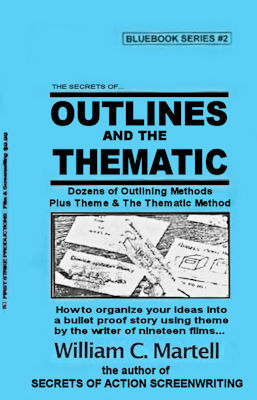
OUTLINES & THE THEMATIC Blue Book.
ARE YOUR SCENES IN THE RIGHT ORDER?
AND ARE THEY THE RIGHT SCENES?
Your story is like a road trip... but where are you going? What's the best route to get there? What are the best sights to see along the way? Just as you plan a vacation instead of just jump in the car and start driving, it's a good idea to plan your story. An artist does sketches before breaking out the oils, so why shouldn't a writer do the same? This Blue Book looks at various outlining methods used by professional screenwriters like Wesley Strick, Paul Schrader, John August, and others... as well as a guest chapter on novel outlines. Plus a whole section on the Thematic Method of generating scenes and characters and other elements that will be part of your outline. The three stages of writing are: Pre-writing, Writing, and Rewriting... this book looks at that first stage and how to use it to improve your screenplays and novels.
Only $4.99 - and no postage!
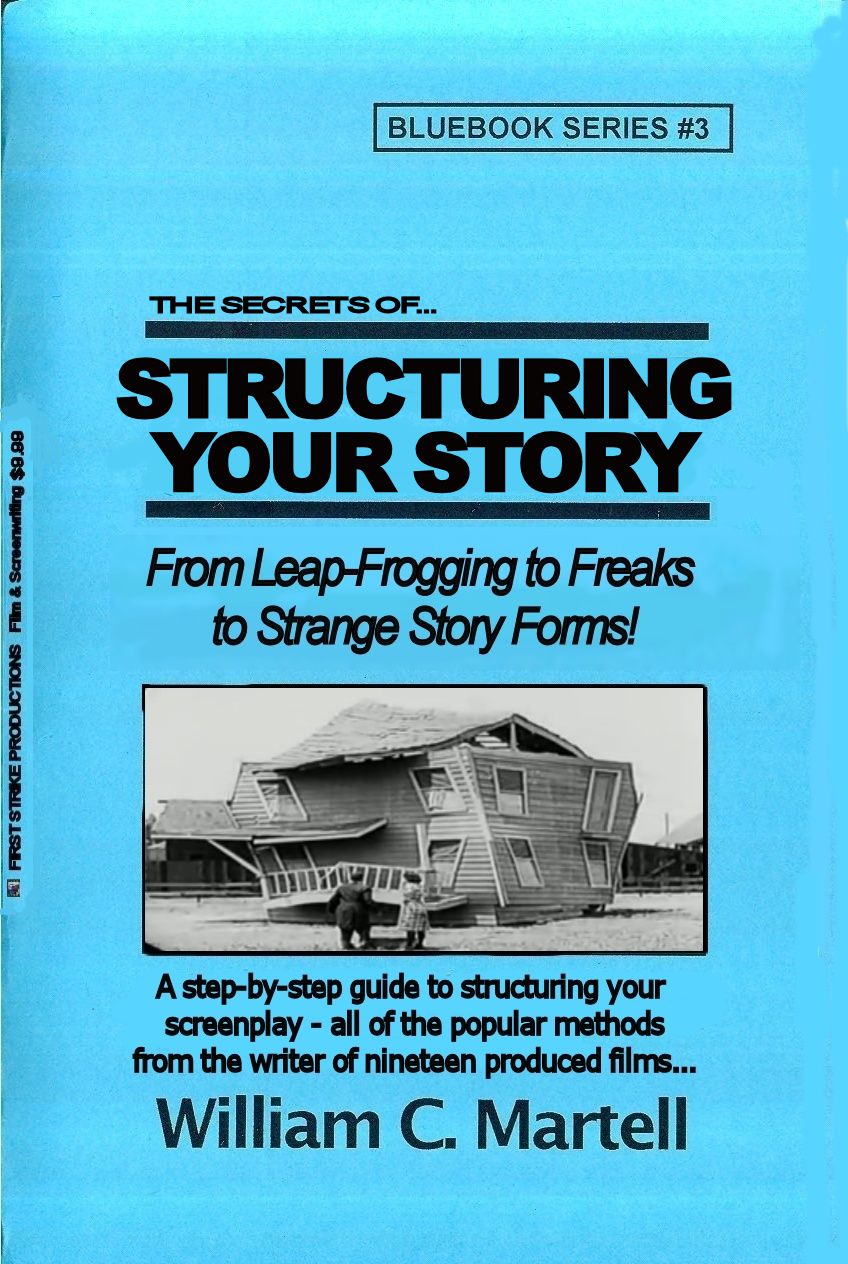
GOT STRUCTURE?!
*** STRUCTURING YOUR STORY *** - For Kindle!
William Goldman says the most important single element of any screenplay is structure. It’s the skeleton under the flesh and blood of your story. Without it, you have a spineless, formless, mess... a slug! How do you make sure your structure is strong enough to support your story? How do you prevent your story from becoming a slug? This Blue Book explores different types of popular structures from the basic three act structure to more obscure methods like leap-frogging. We also look at structure as a verb as well as a noun, and techniques for structuring your story for maximum emotional impact. Most of the other books just look at *structure* and ignore the art of *structuring* your story. Techniques to make your story a page turner... instead of a slug!
Only $4.99 - and no postage!

STORY: WELL TOLD!
*** STORY: WELL TOLD *** - For Kindle!
This book takes you step-by-step through the construction of a story... and how to tell a story well, why Story always starts with character... but ISN'T character, Breaking Your Story, Irony, Planting Information, Evolving Story, Leaving No Dramatic Stone Unturned, The Three Greek Unities, The Importance Of Stakes, The Thematic Method, and how to create personal stories with blockbuster potential. Ready to tell a story?
Print version was 48 pages, Kindle version is over 85,000 words - 251 pages!
Only $4.99 - and no postage!

START STRONG!
*** HOOK 'EM IN TEN *** - For Kindle!
Your story doesn't get a second chance to make a great first impression, and this book shows you a
bunch of techniques on how to do that. From the 12 Basic Ways To Begin Your Story, to the 3 Stars Of
Your First Scene (at least one must be present) to World Building, Title Crawls, Backstory, Starting
Late, Teasers and Pre Title Sequences, Establishing Theme & Motifs (using GODFATHER PART 2), Five Critical
Elements, Setting Up The Rest Of The Story (with GODFATHER), and much more! With hundreds of examples
ranging from Oscar winners to classic films like CASABLANCA to some of my produced films (because
I know exactly why I wrote the scripts that way). Biggest Blue Book yet!
Print version was 48 pages, Kindle version is over 100,000 words - 312 pages!
Only $4.99 - and no postage!
NO KINDLE REQUIRED! Get the *free* app (any device, except your Mr. Coffee) on the order page on Amazon!
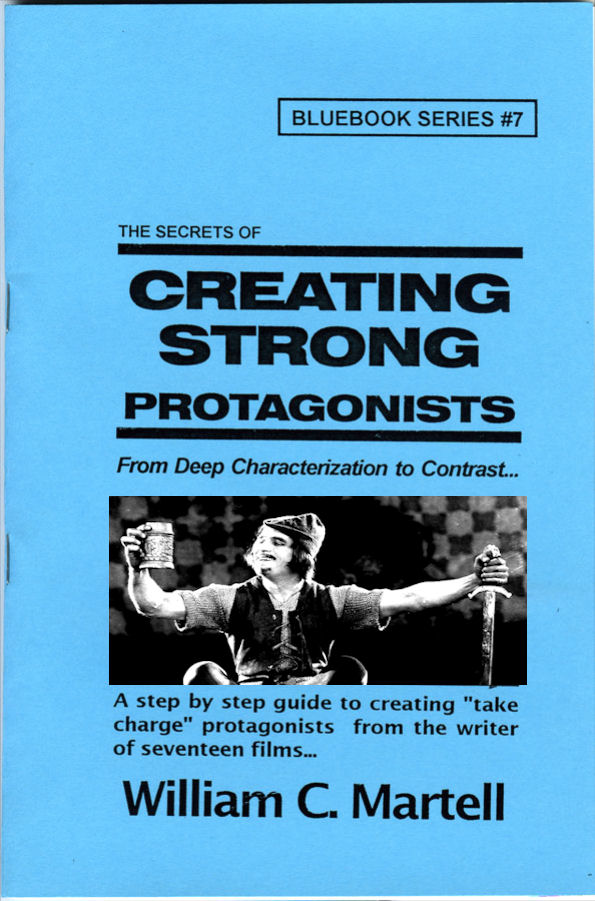
MOVIES ARE CHARACTERS!
*** CREATING STRONG PROTAGONISTS *** - For Kindle!
*** CREATING STRONG PROTAGONISTS *** - For Nook!
Expanded version with more ways to create interesting protagonists! A step-by-step guide to creating "take charge" protagonists. Screenplays are about characters in conflict... characters in emotional turmoil... Strong three dimensional protagonists who can find solutions to their problems in 110 pages. But how do you create characters like this? How do you turn words into flesh and blood? Character issues, Knowing Who Is The Boss, Tapping into YOUR fears, The Naked Character, Pulp Friction, Man With A Plan, Character Arcs, Avoiding Cliche People, Deep Characterization, Problem Protagonists, 12 Ways To Create Likable Protagonists (even if they are criminals), Active vs. Reactive, The Third Dimension In Character, Relationships, Ensemble Scripts, and much, much more. Print version is 48 pages, Kindle version is once again around 205 pages!
ONLY $4.99 - and no postage!
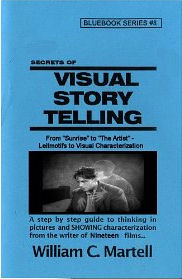
I WRITE PICTURES!
*** VISUAL STORYTELLING *** - For Kindle! (exclusive)
Show Don't Tell - but *how* do you do that? Here are techniques to tell stories visually! Using Oscar Winning Films and Oscar Nominated Films as our primary examples: from the first Best Picture Winner "Sunrise" (1927) to the Oscar Nominated "The Artist" (which takes place in 1927) with stops along the way Pixar's "Up" and Best Original Screenplay Winner "Breaking Away" (a small indie style drama - told visually) as well as "Witness" and other Oscar Winners as examples... plus RISE OF THE PLANET OF THE APES. Print version is 48 pages, Kindle version is over 200 pages!
ONLY $4.99 - and no postage!
DESCRIPTION & VOICE Blue Book!
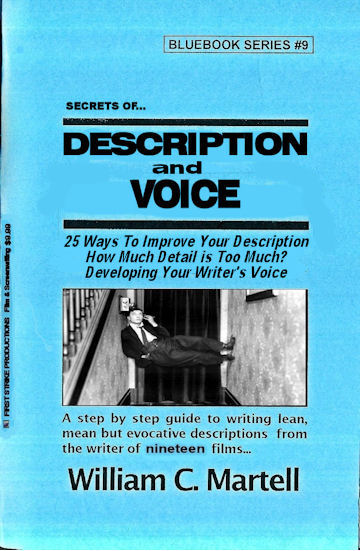
DESCRIPTION & VOICE Blue Book.
IS HALF OF YOUR STORY IN TROUBLE?
Most screenplays are about a 50/50 split between dialogue and description - which means your description is just as important as your dialogue. It just gets less press because the audience never sees it, the same reason why screenwriters get less press than movie stars. But your story will never get to the audience until readers and development executives read your script... so it is a very important factor. Until the movie is made the screenplay is the movie and must be just as exciting as the movie. So how do you make your screenplay exciting to read? Description is important in a novel as well, and the “audience” does read it... how do we write riveting description?
Only $4.99 and no postage!

PRO DIALOGUE TECHNIQUES!
*** DIALOGUE SECRETS *** - For Kindle!
***
Expanded version with more ways to create interesting dialogue! How to remove bad dialogue (and what *is* bad dialogue), First Hand Dialogue, Awful Exposition, Realism, 50 Professional Dialogue Techniques you can use *today*, Subtext, Subtitles, Humor, Sizzling Banter, *Anti-Dialogue*, Speeches, and more. Tools you can use to make your dialogue sizzle! Special sections that use dialogue examples from movies as diverse as "Bringing Up Baby", "Psycho", "Double Indemnity", "Notorious", the Oscar nominated "You Can Count On Me", "His Girl Friday", and many more! Print version is 48 pages, Kindle version is over 175 pages!
Only $4.99 - and no postage!

WHAT IS A SCENE?
*** SCENE SECRETS *** - For Kindle!
***
What is a scene and how many you will need? The difference between scenes and sluglines. Put your scenes on trial for their lives! Using "Jaws" we'll look at beats within a scene. Scene DNA. Creating set pieces and high concept scenes. A famous director talks about creating memorable scenes. 12 ways to create new scenes. Creating unexpected scenes. Use dramatic tension to supercharge your scenes. Plants and payoffs in scenes. Plus transitions and buttons and the all important "flow"... and more! Over 65,000 words! Print version was 48 pages, Kindle version is around 210 pages!
Only $4.99 - and no postage!
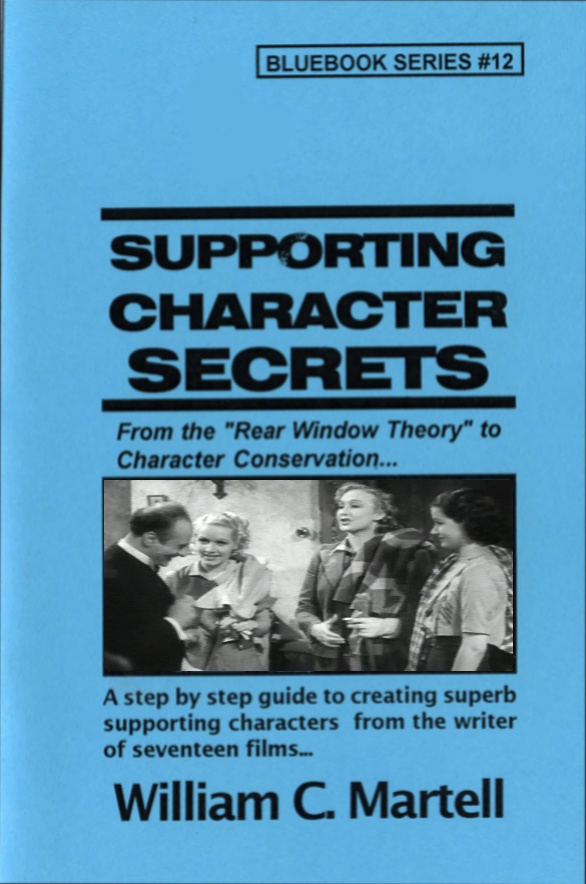
SUBPLOTS?
*** SUPPORTING CHARACTER SECRETS *** - For Kindle! (Exclusive)
Expanded version with more techniques to flesh out your Supporting Characters and make them individuals. Using the hit movie BRIDESMAIDS as well as other comedies like THE HANGOVER and TED and HIGH FIDELITY and
40 YEAR OLD VIRGIN and many other examples we look at ways to make your Supporting Characters come alive on the page.
Print version was 48 pages, Kindle version is around 170 pages!
ONLY $4.99 - and no postage!
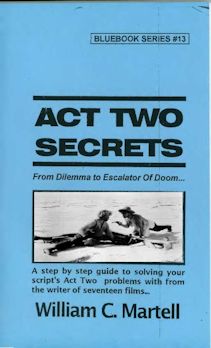
ACT TWO SOLUTIONS!
*** ACT TWO SECRETS *** - For Kindle!
Expanded version with more techniques to help you through the desert of Act Two! Subjects Include: What Is Act Two? Inside Moves, The 2 Ps: Purpose & Pacing, The 4Ds: Dilemma, Denial, Drama and Decision, Momentum, the Two Act Twos, Subplot Prisms, Deadlines, Drive, Levels Of Conflict, Escalation, When Act Two Begins and When Act Two Ends, Scene Order, Bite Sized Pieces, Common Act Two Issues, Plot Devices For Act Two, and dozens of others. Over 67,000 words (that’s well over 200 pages) of tools and techniques to get you through the desert of Act Two alive!
Print version was 48 pages, Kindle version is well over 200 pages!
ONLY $4.99 - and no postage!
All About Endings!
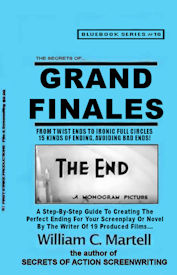
GRAND FINALES Blue Book!
The Perfect Ending For Your Story!
The First Ten Pages Of Your Screenplay Are Critical,
But What About The Last 10 Pages?
Creating the perfect ending to your story! This 100,000 word book shows you how to end your story with a bang, rather than a whimper. Everything from Resolution Order to Act Three Tools to Happy or Sad Endings? to How The Beginning Of Your Story Has Clues To The Ending (in case you were having trouble figuring out how the story should end) to Falling Action to How To Avoid Bad Endings to Writing The Perfect Twist Ending to Setting Up Sequels & Series to Emotional Resolutions to How To Write Post Credit Sequences to Avoiding Deus Ex Machinas, to 20 Different Types Of Ends (and how to write them) and much more! Everything about endings for your screenplay or novel!
Only: $4.99
NO KINDLE REQUIRED! Get the *free* app (any device, except your Mr. Coffee) on the order page on Amazon!
All About LOGLINES, TREATMENTS, and PITCHING!

LOGLINES, TREATMENTS, and PITCHING! Blue Book!
Distilling Your Screenplay!
Loglines, Treatments, Pitching, Look Books, Pitch Decks, One Pagers, Rip-O-Matics?
You have written a brilliant 110 page screenplay, but how do you get anyone to read it? You need to distill it down into some form of verbal moonshine or story rocket fuel that will ignite that bored development executive or manager or agent and get them to request your screenplay. But how do you shrink those 110 pages into a 25 word logline or a 2 minute elevator pitch or a one page synopsis or a short paragraph? This 100,000 word book shows you how! Everything you need to know! From common logline mistakes (and how to solve them) to how your pitch can reveal story problems to the 4 types of pitches!
272 Pages - ONLY $4.99!
READY TO BREAK IN?
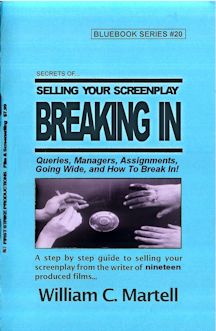
THE BUISINESS SIDE
*** BREAKING IN BLUE BOOK *** - For Kindle!
Should really be called the BUSINESS BLUE BOOK because it covers almost everything you will need to
know for your screenwriting career: from thinking like a producer and learning to speak their language,
to query letters and finding a manager or agent, to making connections (at home and in Hollywood) and
networking, to the different kinds of meetings you are will have at Studios, to the difference between
a producer and a studio, to landing an assignment at that meeting and what is required of you when you
are working under contract, to contracts and options and lawyers and... when to run from a deal!
Information you can use *now* to move your career forward! It's all here in the Biggest Blue Book yet!
Print version was 48 pages, Kindle version is over 400 pages!
$4.99 - and no postage!

Use your creative energy to focus on the content; let Final Draft take care of the style. Final Draft is the number-one selling application specifically designed for writing movie scripts, television episodics and stage plays. Its ease-of-use and time-saving features have attracted writers for almost two decades positioning Final Draft as the Professional Screenwriters Choice. Final Draft power users include Academy, Emmy and BAFTA award winning writers like Oliver Stone, Tom Hanks, Alan Ball, J.J. Abrams, James Cameron and more.
* * * Buy It!
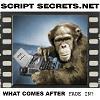
|

